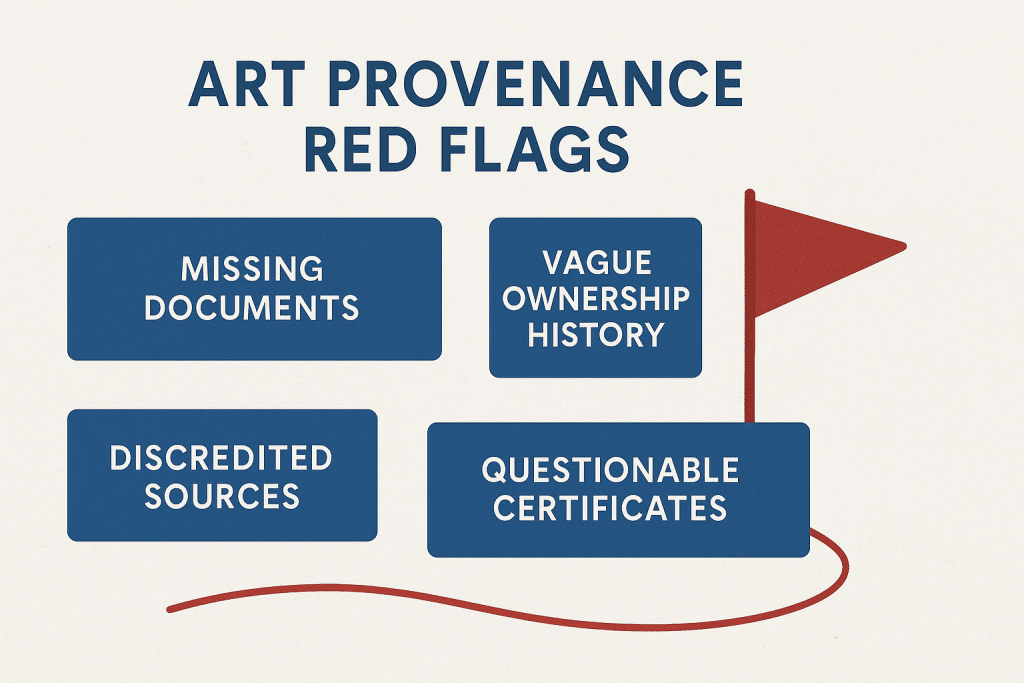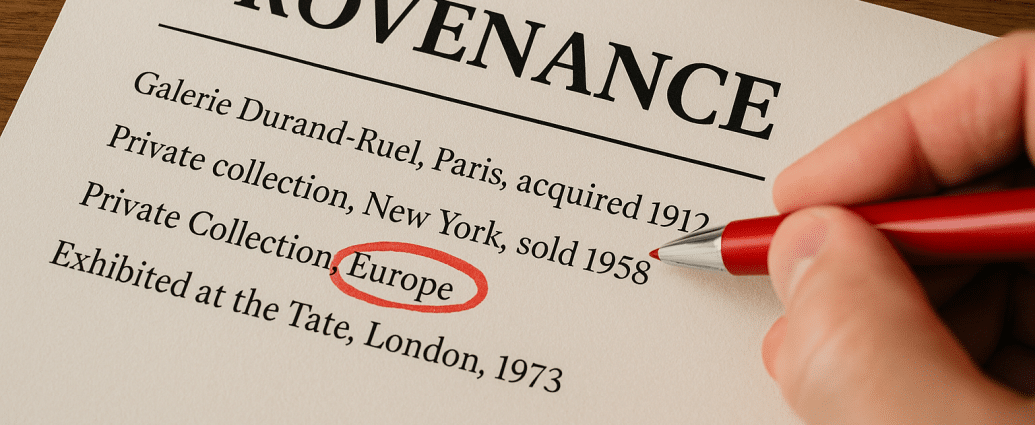Every artwork carries a story — but sometimes that story is incomplete, misleading, or outright false. While provenance is meant to establish authenticity and ownership, fraudulent or weak documentation has been at the heart of some of the biggest art scandals in history.
For collectors at all levels, recognising red flags in provenance is essential. A painting with vague paperwork or unexplained ownership gaps may be worth little more than the canvas it is painted on. In this article, we break down the most common warning signs, show you what to watch for, and explain how to protect yourself.
For a complete overview of provenance, see our Ultimate Guide to Art Provenance.
Why Red Flags Matter
- Provenance is central to authenticity and value.
- Auction houses and insurers will refuse works with questionable provenance.
- Even affordable art can lose all resale value if its documentation is suspect.
As with all collecting, prevention is better than cure: it’s far easier to walk away from a suspicious piece than to deal with financial loss later.
Red Flag #1: Vague Ownership Statements
Phrases such as “Private collection, Europe” or “From a renowned collector” are meaningless unless they include specific names, dates, or locations.
Why it matters:
- Vague claims cannot be verified.
- They are often used to cover missing or fabricated ownership history.
What to do: Ask for clarity. If a seller cannot provide names or corroborating documents, be cautious.
Red Flag #2: Gaps in the Provenance Timeline
Strong provenance shows a continuous chain of ownership. If decades are missing, it’s a problem.
Why it matters:
- Gaps create opportunities for forgeries to be inserted into the record.
- Works looted during wartime often surface with “lost years.”
What to do: Cross-check dates with catalogues raisonnés, auction databases, or expert opinions.
Red Flag #3: Generic or Fake Certificates
Certificates of authenticity (COAs) are one of the most commonly abused documents. A piece of paper stamped “authentic” is meaningless without context.
Warning signs:
- No issuing authority (artist, estate, or recognised gallery).
- Printed on low-quality paper without seals, signatures, or detailed descriptions.
- Certificates that are photocopies rather than originals.
See our article How to Read Provenance Documents Like a Pro for a detailed breakdown of what a genuine certificate should look like.
Red Flag #4: Inconsistent Information
When details don’t align, it’s a serious red flag. Examples include:
- An invoice describing an oil painting when the work is acrylic.
- Dates of creation that don’t match the artist’s known career.
- Dimensions that don’t match the physical artwork.
Even small discrepancies can cast doubt on the entire record.
Red Flag #5: Overly Dramatic Provenance Stories
If a seller insists a piece was “recently discovered in an attic” or “hidden away since the war,” approach with caution.
Why it matters:
- These stories often appeal to emotion rather than evidence.
- Without documentation, such claims are impossible to substantiate.
What to do: Ask for receipts, exhibition records, or expert verification.

Red Flag #6: Dubious Sources
Where you buy matters. Works sourced from unknown dealers, flea markets, or online listings without seller transparency are more likely to come with problematic provenance.
What to do: Stick to reputable galleries, established auction houses, and trusted platforms. For guidance, see our Where to Buy Art Online.
Famous Examples of Red Flags in Action
- Knoedler Gallery scandal (1990s–2000s): Dozens of forged Abstract Expressionist works sold with fabricated provenance, costing buyers over $80 million.
- Modigliani forgeries: Entire exhibitions have been shut down after provenance records were revealed to be false or incomplete.
- Nazi-looted art cases: Missing provenance between 1933–1945 is always a red flag requiring extra scrutiny.
For more stories, see our forthcoming cluster piece Famous Forgeries Exposed by Flawed Provenance.
How to Protect Yourself
- Request documentation for every purchase.
- Cross-check details with catalogues raisonnés, auction databases, and art foundations.
- Ask experts when records look suspicious.
- Trust your instincts — if something feels off, it probably is.
Quick Checklist: Provenance Red Flags
- Ownership described only as “private collection” with no details
- Missing decades in provenance timeline
- Certificates without signatures, seals, or detailed descriptions
- Contradictions between paperwork and physical artwork
- Dramatic, unverifiable stories
- Purchases offered by untraceable dealers or sellers
Conclusion
Recognising provenance red flags is one of the most important skills a collector can develop. Whether you are buying a £100 print or a six-figure painting, weak or fabricated paperwork undermines both authenticity and value.
By learning to spot vague claims, missing gaps, and poor certificates, you protect yourself from costly mistakes.
For next steps, explore:


1 Comment